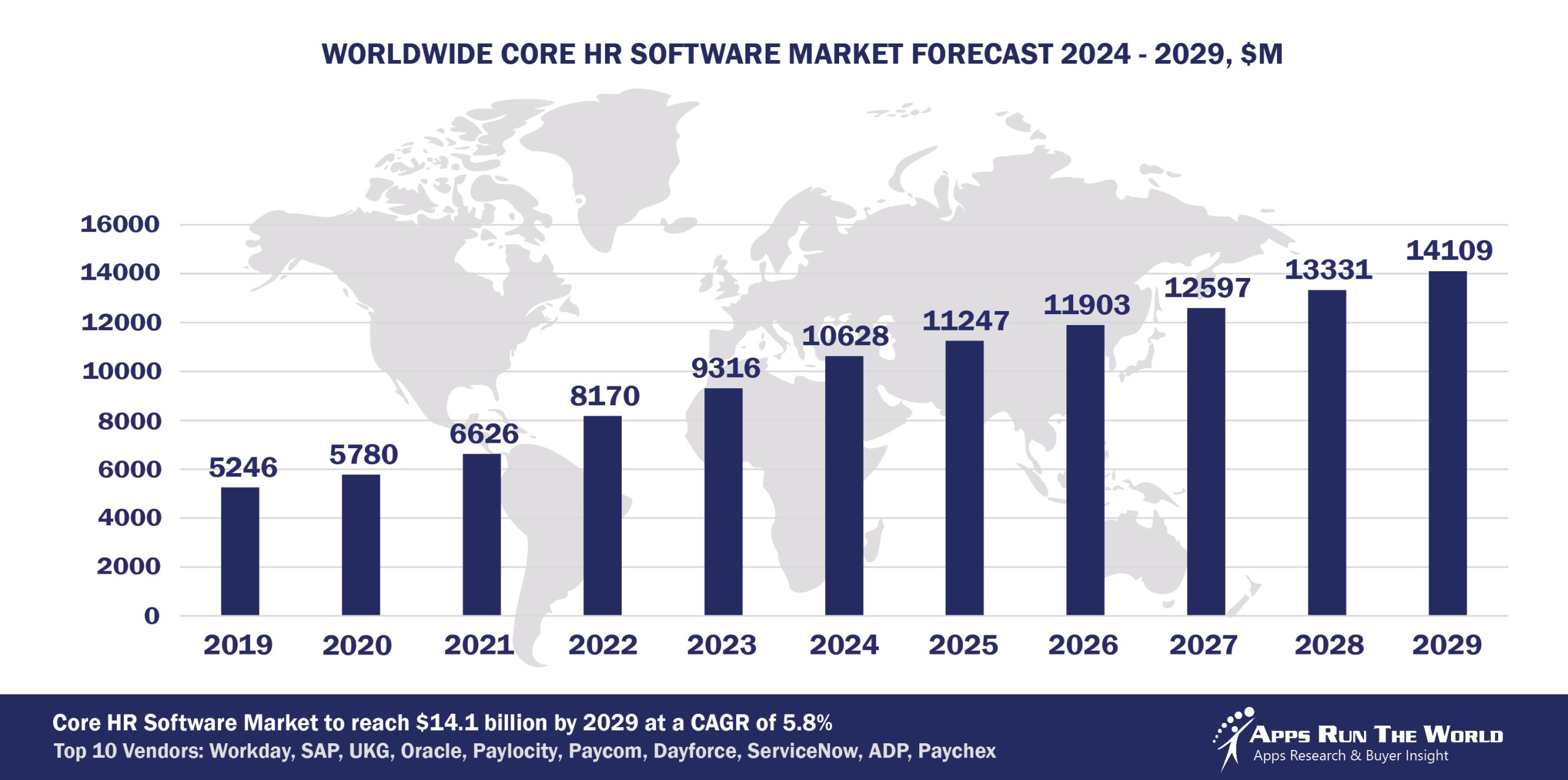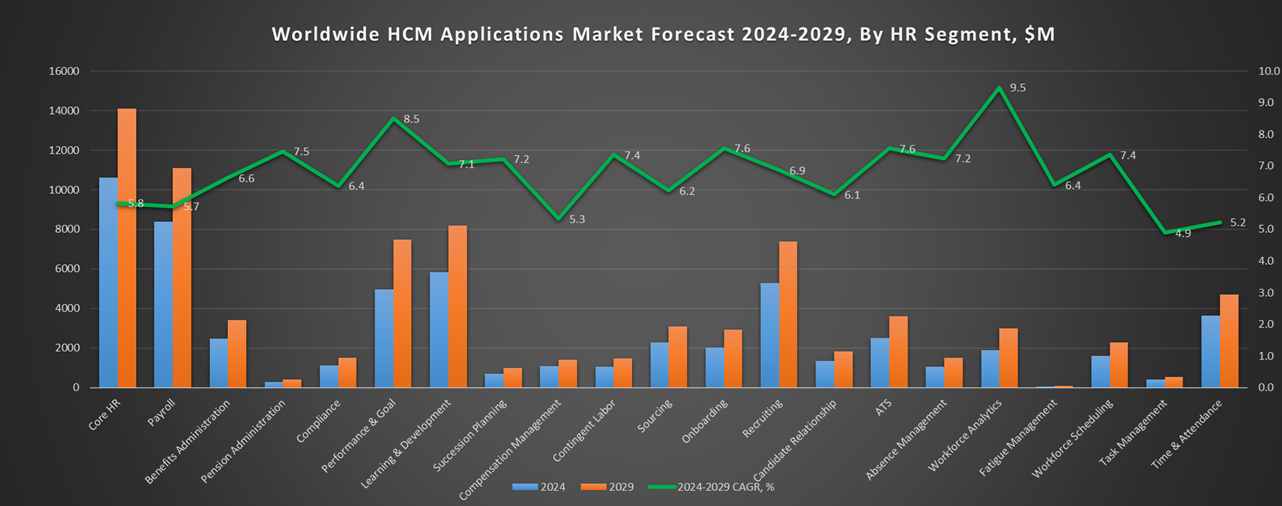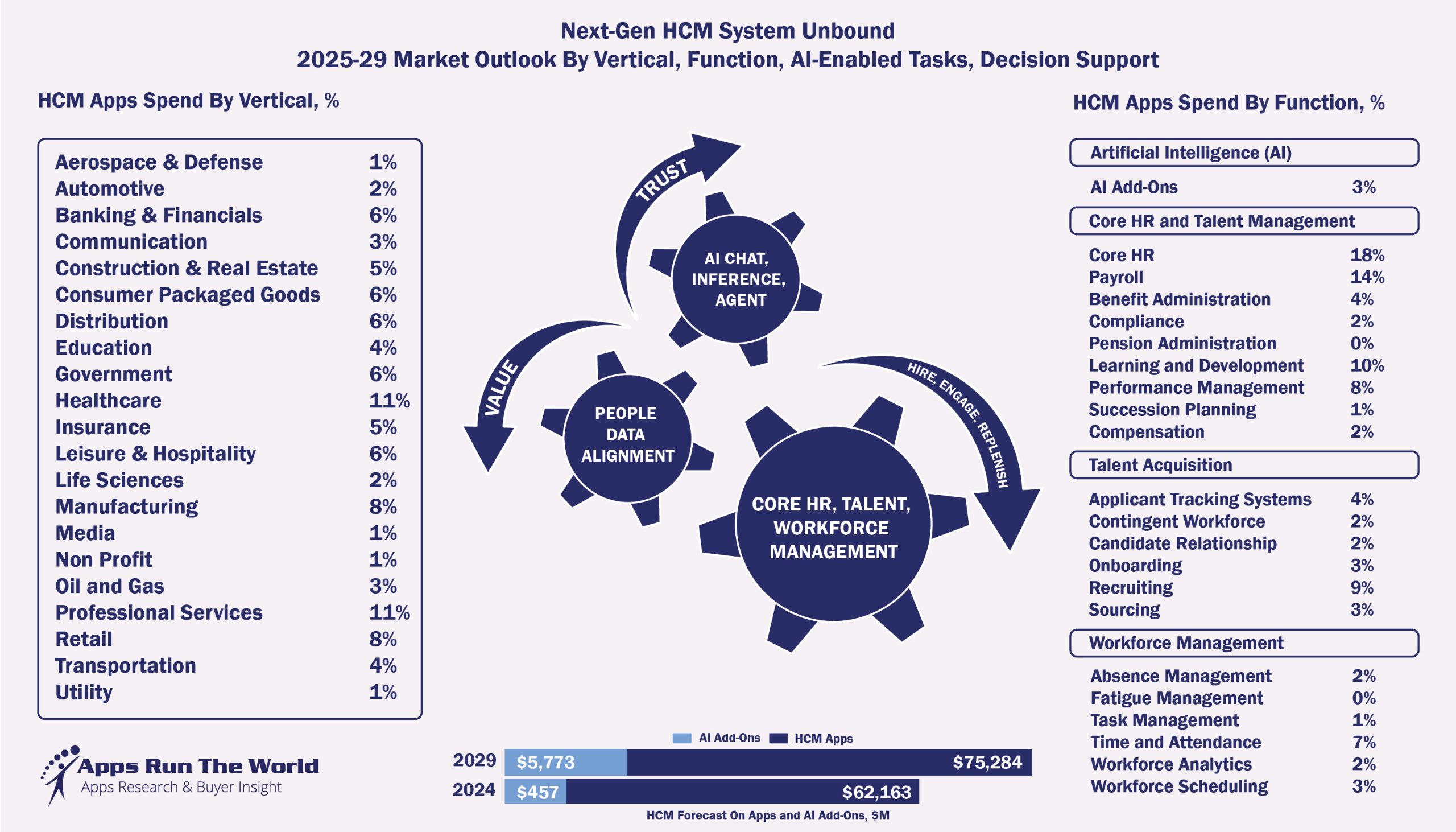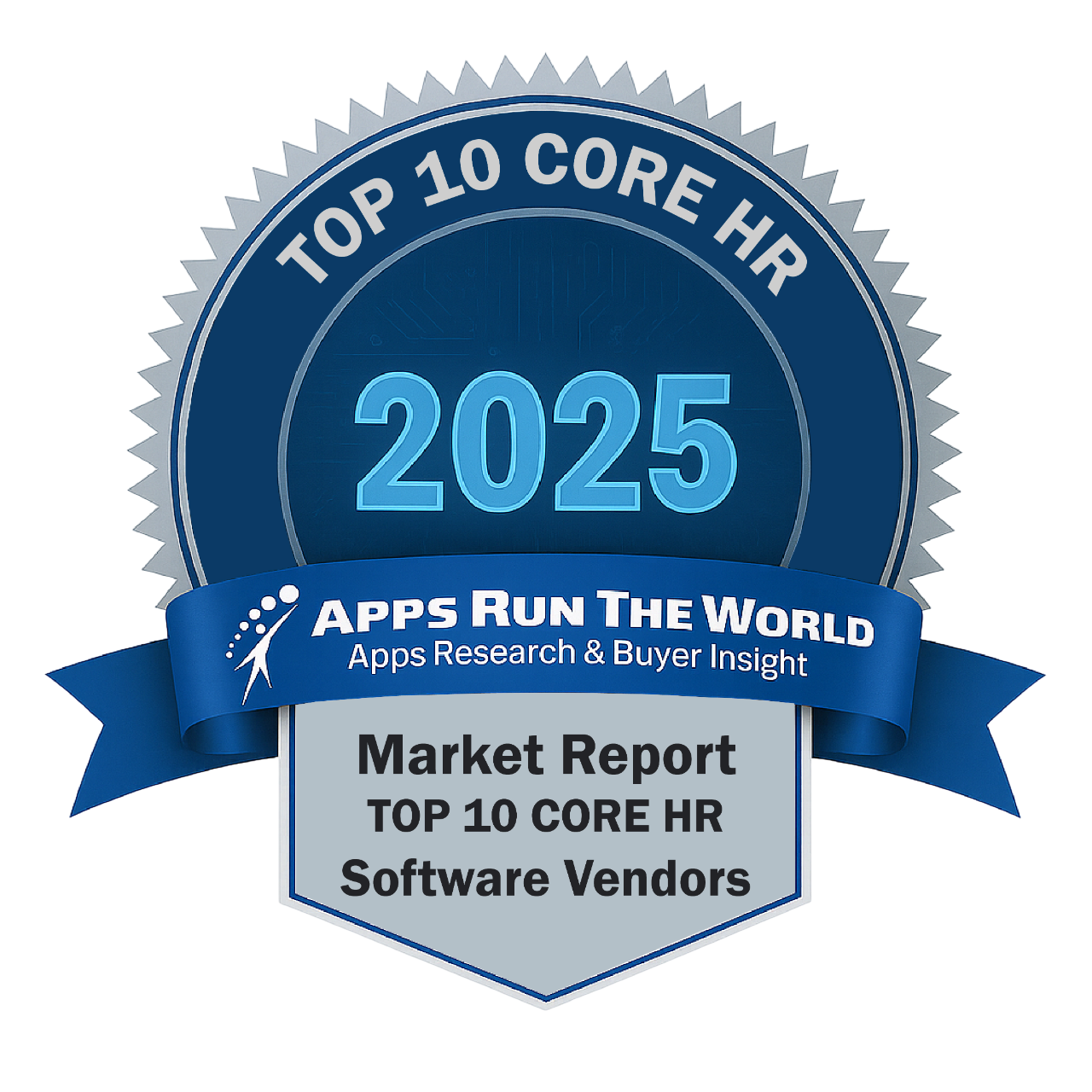
In 2024, the global Core HR software market grew to $10.6 billion, marking a 14.1% year-over-year increase. The top 10 vendors accounted for 70.3% of the total market. Workday led the pack with a 33.8% market share, followed by SAP, UKG, and Oracle.
Through our forecast period, the Core HR applications market size is expected to reach $14.1 billion by 2029, compared with $10.6 billion in 2024 at a CAGR of 5.8%, as shown in the Apps Top 500 Report – Excel Edition [Preview] .
Top 10 Core HR Software Vendors in 2024 and their Market Shares
Source: Apps Run The World, July 2025
Other Personnel and Organization Management software providers included in the report are: Access Group, Advanced, Alight Solutions, Asseco Group, Asure Software, ATOSS, BambooHR, TruBridge (Formerly Computer Programs and Systems), Constellation Software, Cegid, Civica, Cornerstone OnDemand, DATEV, Ellucian, Epicor, Equifax, Frontier Software, Haufe, Hilan, HITS Solutions, HR Cloud, IBM, Ignite Technologies, Infor, Ingentis, Insperity, Inc., Interbiz Solutions, IRIS Software, iSolved, Kingdee, Madison Performance Group, MHR International Ltd, MYOB, Nakisa, Namely, a Vensure Employer Solutions Company, OBIC, Orgvue (formerly Concentra Analytics), P&I Personal & Informatik, Paycom, Paycor, PowerSchool Group, PlanSource, Intuit, Inc., Ramco Systems, Roper Technologies, Reynolds and Reynolds, Sage, Skillsoft, SD Worx, Senior Sistemas, ServiceNow, Rival (formerly SilkRoad Technology), Sopra Steria, Skyward, SoftOne Group, Sprout Solutions, Symphony Talent, Talentia Software, TechnologyOne, TotalSoft, TOTVS, UNIT4, Visma, Vizient, Yonyou, Zellis (ex NGA Human Resources UK & Ireland), Zoho Corp, and many others.
Vendor Snapshot: Core HR Software Market Leaders
 Workday
Workday
Workday is reinforcing its position in enterprise HCM by integrating agentic AI across its core modules—including HCM, Payroll, and Recruiting. Through strategic acquisitions like HiredScore and VNDLY, it has added advanced recruiting and contingent workforce orchestration capabilities. Workday’s agentic roadmap emphasizes embedded skills orchestration and talent lifecycle agents that automate candidate rediscovery, onboarding workflows, compensation simulations, and engagement nudges. Its open ecosystem approach—called “The Workday Economy”—encourages partner-built agents that augment native modules with conversational interfaces and low-code configurability, enabling smarter, faster workforce agility at scale.
SAP
SAP’s SuccessFactors suite—including Employee Central, Recruiting, and Learning—is undergoing a transformation underpinned by Joule, SAP’s intelligent copilot. Joule Studio enables customers to build conversational agents that track skill gaps, auto-schedule training, validate candidate fit, and generate succession pipelines. With the pending SmartRecruiters acquisition, SAP is enhancing high-volume recruitment automation and candidate engagement agents. Meanwhile, SAP Fieldglass extends this agentic vision into external workforce management, with AI-enabled vendor and contingent labor optimization capabilities that complement internal talent strategies. The AI Core and BTP framework unify governance, semantic modeling, and agent orchestration, positioning SAP as a leader in fully embedded, modular AI across both permanent and external workforce ecosystems.
UKG
UKG is reimagining workforce management and HCM via its Pro and Ready products with Bryte AI Agents embedded in scheduling, time tracking, and forecasting. These agents anticipate labor demand, optimize shift assignments, and alert managers to compliance risks. UKG’s AI Hub marketplace enables deployment of modular agentic components for specific operations—such as seasonal hiring and global payroll—powered by recent acquisitions of Great Place to Work, Shiftboard and Immedis. This strategy supports flexible, use-case-driven adoption while offering low-code tools for conversational configurations and adaptive scheduling workflows across large workforces.
Oracle
Oracle is layering agentic innovation into its Oracle Cloud HCM, Payroll, and Recruiting offerings, with internal GenAI Innovator programs focused on talent matching and natural-language workflow bots. Oracle’s embedded agents help guide compensation cycles, perform workforce forecasting, and support conversational jobs-to-roles matching across employee and candidate data. Recognition for AI-driven talent acquisition capabilities underscores Oracle’s preference for building platform-first agentic features rather than relying on acquisitions. Its roadmap supports modular deployment of HR copilots into any core HCM process, reinforcing a unified, strategically AI-enhanced talent foundation.
Paylocity
Paylocity’s HCM suite is augmented by Paylocity AI: intelligent agents that automate benefits recommendations, predictive staffing alerts, and performance cycle nudges. Its standalone conversational AI Assistant assists employees with onboarding, scheduling, and HR policy queries. Embedded across payroll and HR modules, these agents deliver proactive insights and streamline routine tasks. With integrated analytics connectors and machine learning-powered retention modeling, Paylocity is positioning itself as an accessible, agent-driven platform for mid-market talent management.
Paycom
Paycom’s unified architecture now includes conversational assistants powered by its IWant AI engine, automating tasks such as HR query resolution and time-off approvals. These agents use real-time business rules to accelerate decision-making and reduce administrative workload. Latest UX improvements support voice-based employee interaction and intuitive forecasting guidance for payroll and benefits. Paycom emphasizes organic growth and operational excellence, deploying agentic functionality incrementally across modules to improve usability and drive adoption in mid-market enterprises.
Dayforce
Dayforce is evolving its real-time HCM platform by embedding agentic AI across payroll, workforce scheduling, and talent management workflows. With continuous calculation at its core, Dayforce enables instantaneous payroll insights and real-time compliance monitoring—capabilities essential for large, complex enterprises. Recent M&A activity includes the acquisition of eloomi, enhancing the platform’s learning and development tools with adaptive content delivery, and Ideal, a talent intelligence firm whose AI is now powering automated candidate screening and workforce analytics. These moves align with Dayforce’s vision to unify HR, payroll, and workforce intelligence under a single system-of-record powered by embedded AI agents, all while expanding its global reach and end-to-end workforce optimization capabilities.
ServiceNow
The new ServiceNow Core Business Suite, launched in late 2024, uses agents to automate HR case resolution and surface workforce insights. ServiceNow’s HRSD roadmap makes the platform an agent control tower: HR teams can deploy workflow bots (for onboarding, requests, etc.) that tap the same unified data model. The result is an HR solution where conversational AI and autonomous workflows are first-class. ServiceNow insists its agents collaborate like extensions of their human counterparts and integrate seamlessly with existing HR workflows.
ADP
ADP, the undisputed leader in payroll processing with over one million clients globally, is embedding intelligent automation across its Enterprise HCM and Workforce Now platforms. At the core is ADP Payroll, re-engineered for real-time compliance checks, multi-jurisdictional tax optimization, and autonomous retroactive calculations. Its Lyric architecture supports scalable AI services—like automated compensation modeling and employee sentiment tracking—within a low-code governance framework. The acquisition of WorkForce Software expands global time-tracking and scheduling capabilities, while ADP’s substantial R&D spend fuels development of predictive analytics, no-code workflow tools, and intelligent employee self-service—solidifying its position as the foundational system-of-record for global payroll and intelligent workforce management.
Paychex
Paychex’s approach is to add focused AI assistants into its SMB-oriented HCM. In 2024, Paychex launched Recruiting Copilot, an AI talent-search engine in Paychex Flex that matches small businesses with candidates via natural-language queries. Paychex also rolled out an advanced analytics suite, HR Analytics Premium Plus, with embedded AI Insights. The AI Insights assistant lets HR leaders ask questions of their own data in plain language and immediately see reports. Additionally, in April 2025, Paychex completed the acquisition of Paycor HCM for $4.1 billion. This acquisition strengthens Paychex’s position in the upmarket segment, expands its AI-driven HR technology capabilities, and provides new growth channels.
ARTW Technographics Platform: Core HR customer wins
Since 2010, our research team has been studying the patterns of Core HR software purchases, analyzing customer behavior and vendor performance through continuous win/loss analysis. Updated quarterly, the ARTW Technographics Platform provides deep insights into thousands of Core HR customer wins and losses, helping users monitor competitive shifts, evaluate vendor momentum, and make informed go-to-market decisions.
List of Core HR customers
Source: ARTW Buyer Insights Technographic Database
Custom data cuts related to the Core HR Applications market are available:
- Top 500+ Core HR Applications Vendors and Market Forecast 2024-2029
- 2024 Core HR Applications Market By Vertical Market (21 Industry)
- 2024 Core HR Applications Market By Country (USA + 45 countries)
- 2024 Core HR Applications Market By Region (Americas, EMEA, APAC)
- 2024 Core HR Applications Market By Revenue Type (License, Services, Hardware, Support and Maintenance, Cloud)
- 2024 Core HR Applications Market By Customer Size (revenue, employee count, asset)
- 2024 Core HR Applications Market By Channel (Direct vs Indirect)
- 2024 Core HR Applications Market By Product
Through our forecast period, the HCM applications market is expected to reach $81.1 billion by 2029, compared with $58.7 billion in 2024 at a compound annual growth rate of 11.7%.
Through our forecast period, the Core HR and Talent Management applications market, which is comprised of nine subsegments, is expected to reach $48.6 billion by 2029, compared with $35.5 billion in 2024 expanding at a compound annual growth rate of 11.6%. For the Top 10 vendors in each of the nine subsegments, please check their own index page by following the link below.
Through our forecast period, the Talent Acquisition applications market, which is comprised of six subsegments, is expected to reach $20.3 billion by 2029, compared with $14.5 billion in 2024 expanding at a compound annual growth rate of 11.7%. For the Top 10 vendors in each of the six subsegments, please check their own index page by following the link below.
Through our forecast period, the Workforce Management applications market, which is comprised of six subsegments, is expected to reach $12.1 billion by 2029, compared with $8.7 billion in 2024 expanding at a compound annual growth rate of 12.1%. For the Top 10 vendors in each of the six subsegments, please check their own index page by following the link below.
Our HCM Top 500 research team also tracks Time Clock Hardware vendors separately by zeroing in on their embedded software as well as their extensive use of OEM and distribution partners.
Exhibit 3: Worldwide HCM Software Market 2024-2029 Forecast, $M
Source: Apps Run The World, July 2025
Exhibit 4 shows our projections for the HCM enterprise applications market by HCM sub-segment, based on the buying preferences and the customer propensity to invest in new software within those industries as they continue to upgrade and replace many legacy industry-specific applications that have been identified and tracked in our Buyer Insight Database.

FAQ – APPS RUN THE WORLD Top 10 Core HR (Personnel & Organization Management), Market Size & Forecast
Q1. What is the global Core HR software market size in 2024?
A: The global Core HR (Personnel & Organization Management) software market reached $10.6 billion in 2024, growing 14.1% year-over-year.
Q2. Who are the top 10 Core HR vendors in 2024 and their combined share?
A: The top 10 Core HR software vendors in 2024 account for 70.3% of the worldwide market.
Q3. Which vendor leads the Core HR market in 2024?
A: Workday leads the Core HR software market in 2024, driven by strong demand for its HCM platform across enterprise customers.
Q4. How does this report define the Core HR (Personnel & Organization Management) market scope?
A: Core HR includes HR master records, personnel administration, organizational charts, employee profiles, and time-off accrual management.
Q5. What is the Core HR market outlook through 2029?
A: The Core HR market is projected to grow to $14.1 billion by 2029 at a 5.8% compound annual growth rate.
Q6. Which other vendors are covered beyond the top 10 in Core HR?
A: The report includes additional vendors focused on region-specific and verticalized Core HR platforms serving midsize and enterprise customers.
Q7. When was this report published and by whom?
A: The Top 10 Core HR Software Vendors report was published in July 2025 by APPS RUN THE WORLD analysts as part of the APPS TOP 500 research program, which benchmarks the revenues and market share of the world’s 1,500+ largest enterprise application vendors.
Methodology
Similar to any of the hundreds of reports that we have published since 2010, HCM Top 500 is a labor of love. Since 2013, our team of researchers has been conducting rigorous research on thousands of HCM vendors, surveying them quarterly, reviewing their products at even shorter intervals because of the compressed Cloud release cycle, and discussing HR vision with their customers to better understand user needs as well as different paths to upgrade and replace their existing systems.
Each year we also attend many industry-wide and vendor-specific user conferences – HR Tech, Dreamforce, SAPPHIRENOW, Oracle Open World, just to name a few, to gauge what customers are looking for.
Throughout this process comes a rich database of more than 2,000 HCM vendors as well as over 50,000 HCM customers that have been touched one form or another through regular surveys, phone and in-person interviews, email exchanges, and social media interactions, etc.
On a proactively basis, we contact the vendors directly to tabulate their latest quarterly and annual revenues by HCM segment, vertical market, revenue type, region, country and customer size.
We supplement their written responses with our own primary research to determine quarterly and yearly growth rates in each of the 22 segments and 21 verticals, in addition to customer wins to ascertain whether these are net new purchases or expansions of existing implementations.
Another dimension of our quantitative research process is through continuous improvement of our customer database, which stores more than one million records on the enterprise software landscape of over 100,000 organizations around the world.
The database provides customer insight and contextual information on what types of HCM, enterprise software systems and other relevant technologies are they running and their propensity to invest further with their current or new suppliers as part of their overall HCM and IT transformation projects to stay competitive, fend off threats from disruptive forces, or comply with internal mandates to improve overall enterprise efficiency.
The result is a combination of supply-side data and demand-generation customer insight that allows our clients to better position themselves in anticipation of the next wave that will reshape the HCM marketplace for years to come.
HCM Market Taxonomy

Definition of Human Capital Management (HCM) Applications
Core HR and Performance Management
| Core HR and Performance Management | Description |
|---|---|
| Personnel and Organization Management | Core human resource management system, personnel records, HR master file, accruals, organizational development, org chart visualization |
| Payroll | Payroll processing, tax filing, language support, country-level updates, payslip calculations, automatic deductions and other government requirements for proper disbursement of employee compensation. |
| Benefits Administration | Benefits and health administration. Plan and design benefits lifecycle, billing and payment. Carrier solutions are also included for integration purposes. |
| Pension Administration | Pension and retirement fund(401K) administration as well as software that helps manage profit sharing plan, defined benefit plan, or cash balance plan. |
| Compliance | Compliance, regulatory updates and reporting including such laws as Affordable Care Act, Overtime Regulations, Fair Labor Standards Act |
| Performance and Goal Management | HR performance management applications are designed to automate the aggregation and delivery of information pertinent to the linking of job roles and the mission and goals of the organization. More specifically, the system allows users to automate the performance review process by using mechanisms such as training and key performance indicators to continuously track and monitor the progress of an individual employee, work team, and division. Some of the key features include: Assessment of individual career objectives and organizational skills gaps that impede performance and job advancement. Continuous reviews and establishing milestones. 360-degree evaluation and real-time feedback. Performance appraisal automation. Goal setting and tracking. Employee surveys. Alignment of human assets to corporate objectives. Fast tracks for top performers. |
| Learning and Development | Learning management systems refer to applications that automate the administration, tracking, and reporting of training events. Other tools may include courseware and other delivery, management, tracking, or integrated solutions whose focus is on the learning environment, including learning content management systems. Career development tools include apps for coaching, mentoring, employee development planning, and diagnosing of development needs. |
| Succession and Leadership Planning | Identify and address current and potential talent gaps to create succession management reporting. Develop and maintain a continuous supply of internal talent to fill critical job roles. Improve employee engagement through digital tools to advance career path development opportunities. |
| Compensation Management | Compensation management applications are designed to automate the process of providing cash, noncash, variable and nonvariable compensation to employees through advanced modeling, reporting, and built-in interfacing to payroll processing systems. Other key features include seamlessly manage compensation budgets and allocation in a single, shared tool. Streamline pay recommendation workflows and approvals. Support multiple pay and incentive practices. Ensure budget compliance and adherence to compensation guidelines. Quota and territory management. Calculation and distribution of commissions, spiffs, royalties, incentives to employees, and channel and business partners. Compensation analysis using internal and external data for retention risk analysis. Linking salary, commission and incentives — cash and noncash — to business objectives. Payroll and payment engine interfaces. Account payables integration. |
Talent Acquisition
| Talent Acquisition | Description |
|---|---|
| Applicant Tracking | Applicant tracking software automates such functions as management of resumes, applicant information, scoring, workflow, matching, search, interview scheduling, job descriptions, EEOC reporting, job postings and notifications |
| Recruiting | Recruiting applications are designed to automate the recruitment process of salaried and hourly employees through screening and skills assessment, as well as automated selection processes to improve hiring pipeline by identifying talent inside or outside the organization. Other key features include: Manage skills inventories. Create and manage job requisitions. Coordinate team collaboration within hiring processes. Video Interviewing, team building and digital coaching. |
| Candidate Relationship Management | Applications designed to attract and engage candidates and employees. Other tasks automate functions such as candidate relationship management apps, career site technology, social recruiting, employee referrals, branding, video engagement, campus recruiting and internal hiring |
| Contingent Labor Management | Processing of hiring of contingent labor, search, skills matching, assessment, interview scheduling, negotiation of rates, approvals, project milestone payments, project completion tracking, performance ratings |
| Sourcing | Facilitate resource planning for staffing firms as well as vendor managed system, allowing for front office integration for employment agencies as well as talent acquisition apps designed for staffing firms. |
| Onboarding | Applications designed to deploy workers to appropriate jobs, projects, or teams for accelerated on-boarding. |
Workforce Management
| Workforce Management | Description |
|---|---|
| Absence and Leave Management | Absence management applications offer automated features to support employee leave management, employer authorized leave, Short-Term-Disability/Workers’ Comp coordination, federal and state compliance, customized leave correspondence, medical certification processing, insurance premium payment tracking as well as employee self-service capabilities. Leave Management supports compliance activities related to government regulations such as the Family and Medical Leave Act in the United States and other local leave laws in different countries. |
| Workforce analytics | Workforce analytics are used to analyze compensation, benefits, and other employee variables. These applications can also be used to analyze and optimize labor allocation for particular projects. |
| Fatigue Management | Fatigue Management apps help automate key facets of fatigue risk mitigation, enforcing employee work-hour limits and aligning with fitness for duty best practices. Similar apps may act as electronic work diaries for real-time reporting and compliance with transportation laws. |
| Hardware (Time Clock) | Time capture is the hardware platform that provides authentication features for clock-in and clock-out times, meal and rest breaks, as well as timesheet and payroll reporting and compliance. |
| Scheduling | Products are designed to Increase forecasting accuracy by factoring in a variety of methods and historical patterns. Create optimal schedules to meet customer demands, while reducing costs and maximizing resources |
| Task Management | Task Management offers labor management capabilities such as task-based and project-based activity tracking as well as measurement and reporting functions against performance standards like engineered labor standards, team standards and reflective standards. |
| Time & Attendance | Time and Attendance applications are designed to automate employee time tracking in different locations, help reduce overtime expenses, improve payroll accuracy, eliminate pay errors and adjustments, along with the need to simplify and optimize administrative tasks and complex rate calculations by making available accurate and current labor data and full audit trail of payroll data. |
- HG Insights, a United States based Professional Services organization with 560 Employees
- Timetoact Group Germany, a Germany based Professional Services company with 1700 Employees
- HG Insights, a United States based Professional Services organization with 560 Employees
| Logo | Company | Industry | Employees | Revenue | Country | Evaluated |
|---|


 Workday
Workday